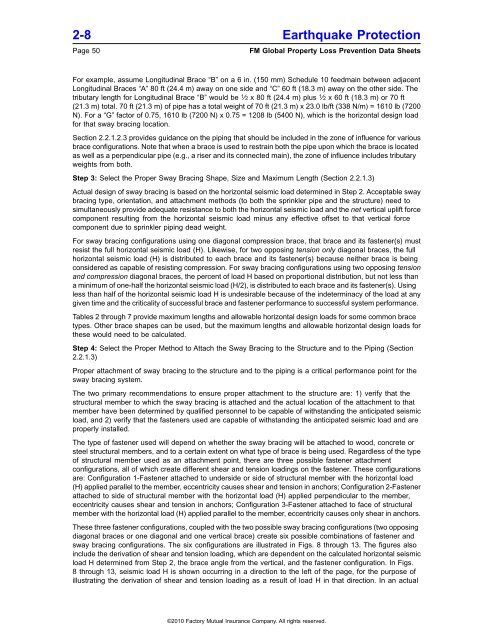DS 2-8 Earthquake Protection for Water-Based Fire ... - FM Global
DS 2-8 Earthquake Protection for Water-Based Fire ... - FM Global
DS 2-8 Earthquake Protection for Water-Based Fire ... - FM Global
Create successful ePaper yourself
Turn your PDF publications into a flip-book with our unique Google optimized e-Paper software.
2-8 <strong>Earthquake</strong> <strong>Protection</strong><br />
Page 50 <strong>FM</strong> <strong>Global</strong> Property Loss Prevention Data Sheets<br />
For example, assume Longitudinal Brace “B” on a 6 in. (150 mm) Schedule 10 feedmain between adjacent<br />
Longitudinal Braces “A” 80 ft (24.4 m) away on one side and “C” 60 ft (18.3 m) away on the other side. The<br />
tributary length <strong>for</strong> Longitudinal Brace “B” would be 1 ⁄ 2 x 80 ft (24.4 m) plus 1 ⁄ 2 x 60 ft (18.3 m) or 70 ft<br />
(21.3 m) total. 70 ft (21.3 m) of pipe has a total weight of 70 ft (21.3 m) x 23.0 lb/ft (338 N/m) = 1610 lb (7200<br />
N). For a “G” factor of 0.75, 1610 lb (7200 N) x 0.75 = 1208 lb (5400 N), which is the horizontal design load<br />
<strong>for</strong> that sway bracing location.<br />
Section 2.2.1.2.3 provides guidance on the piping that should be included in the zone of influence <strong>for</strong> various<br />
brace configurations. Note that when a brace is used to restrain both the pipe upon which the brace is located<br />
as well as a perpendicular pipe (e.g., a riser and its connected main), the zone of influence includes tributary<br />
weights from both.<br />
Step 3: Select the Proper Sway Bracing Shape, Size and Maximum Length (Section 2.2.1.3)<br />
Actual design of sway bracing is based on the horizontal seismic load determined in Step 2. Acceptable sway<br />
bracing type, orientation, and attachment methods (to both the sprinkler pipe and the structure) need to<br />
simultaneously provide adequate resistance to both the horizontal seismic load and the net vertical uplift <strong>for</strong>ce<br />
component resulting from the horizontal seismic load minus any effective offset to that vertical <strong>for</strong>ce<br />
component due to sprinkler piping dead weight.<br />
For sway bracing configurations using one diagonal compression brace, that brace and its fastener(s) must<br />
resist the full horizontal seismic load (H). Likewise, <strong>for</strong> two opposing tension only diagonal braces, the full<br />
horizontal seismic load (H) is distributed to each brace and its fastener(s) because neither brace is being<br />
considered as capable of resisting compression. For sway bracing configurations using two opposing tension<br />
and compression diagonal braces, the percent of load H based on proportional distribution, but not less than<br />
a minimum of one-half the horizontal seismic load (H/2), is distributed to each brace and its fastener(s). Using<br />
less than half of the horizontal seismic load H is undesirable because of the indeterminacy of the load at any<br />
given time and the criticality of successful brace and fastener per<strong>for</strong>mance to successful system per<strong>for</strong>mance.<br />
Tables 2 through 7 provide maximum lengths and allowable horizontal design loads <strong>for</strong> some common brace<br />
types. Other brace shapes can be used, but the maximum lengths and allowable horizontal design loads <strong>for</strong><br />
these would need to be calculated.<br />
Step 4: Select the Proper Method to Attach the Sway Bracing to the Structure and to the Piping (Section<br />
2.2.1.3)<br />
Proper attachment of sway bracing to the structure and to the piping is a critical per<strong>for</strong>mance point <strong>for</strong> the<br />
sway bracing system.<br />
The two primary recommendations to ensure proper attachment to the structure are: 1) verify that the<br />
structural member to which the sway bracing is attached and the actual location of the attachment to that<br />
member have been determined by qualified personnel to be capable of withstanding the anticipated seismic<br />
load, and 2) verify that the fasteners used are capable of withstanding the anticipated seismic load and are<br />
properly installed.<br />
The type of fastener used will depend on whether the sway bracing will be attached to wood, concrete or<br />
steel structural members, and to a certain extent on what type of brace is being used. Regardless of the type<br />
of structural member used as an attachment point, there are three possible fastener attachment<br />
configurations, all of which create different shear and tension loadings on the fastener. These configurations<br />
are: Configuration 1-Fastener attached to underside or side of structural member with the horizontal load<br />
(H) applied parallel to the member, eccentricity causes shear and tension in anchors; Configuration 2-Fastener<br />
attached to side of structural member with the horizontal load (H) applied perpendicular to the member,<br />
eccentricity causes shear and tension in anchors; Configuration 3-Fastener attached to face of structural<br />
member with the horizontal load (H) applied parallel to the member, eccentricity causes only shear in anchors.<br />
These three fastener configurations, coupled with the two possible sway bracing configurations (two opposing<br />
diagonal braces or one diagonal and one vertical brace) create six possible combinations of fastener and<br />
sway bracing configurations. The six configurations are illustrated in Figs. 8 through 13. The figures also<br />
include the derivation of shear and tension loading, which are dependent on the calculated horizontal seismic<br />
load H determined from Step 2, the brace angle from the vertical, and the fastener configuration. In Figs.<br />
8 through 13, seismic load H is shown occurring in a direction to the left of the page, <strong>for</strong> the purpose of<br />
illustrating the derivation of shear and tension loading as a result of load H in that direction. In an actual<br />
©2010 Factory Mutual Insurance Company. All rights reserved.

















